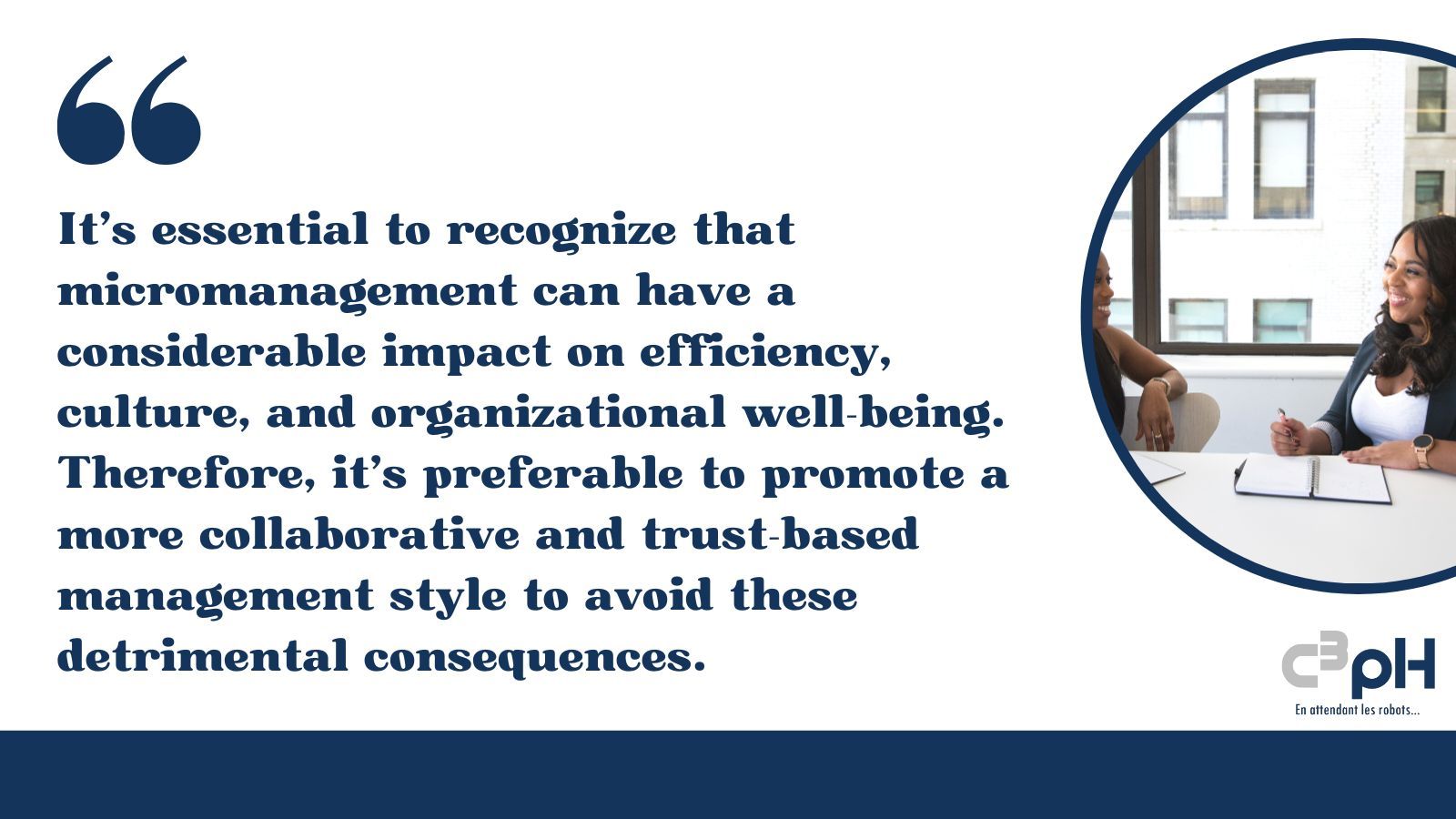Reducing Micromanagement to Free Up Your Time and Foster Trust and Innovation
C3pH

Introduction
Micromanagement is a management behavior where an individual excessively monitors and closely controls the tasks and activities of their colleagues or collaborators.
It is characterized by an excessive involvement in operational details rather than focusing on strategic objectives.
"Micromanagement is a total waste of time for everyone.It exhausts employees, fosters anxiety, and creates a highly stressful work environment. Choose the right people and give them the space necessary to do their job." - Brigette Hyacinth
It is characterized by an excessive involvement in operational details rather than focusing on strategic objectives.
Although it generally stems from good intentions, micromanagement is detrimental in the long run and can have considerable negative impacts on any organization.
"Micromanagement is a total waste of time for everyone.It exhausts employees, fosters anxiety, and creates a highly stressful work environment. Choose the right people and give them the space necessary to do their job." - Brigette Hyacinth
As a manager, it's important to learn to trust your team and sometimes let go. In an ideal world, a team should be capable of carrying out their work and achieving their goals even if the manager is absent.
Key Signs of Micromanagement
Now that we've defined what micromanagement is, how exactly can it be recognized? Those experiencing it can typically identify it quite easily.
Conversely, it's more challenging to recognize it when we're the managers. In fact, it's impossible to list all the elements that might indicate that you're micromanaging.
However, the five signs presented below might prompt you to reflect on your own behaviors. Remember, just because one of these elements applies to you doesn't necessarily mean you're micromanaging.
Conversely, it's more challenging to recognize it when we're the managers. In fact, it's impossible to list all the elements that might indicate that you're micromanaging.
However, the five signs presented below might prompt you to reflect on your own behaviors. Remember, just because one of these elements applies to you doesn't necessarily mean you're micromanaging.
Sign #1: Frequent and Endless Meetings: Individuals who micromanage tend to organize many meetings to closely monitor their team's work and progress, often without real necessity. To evaluate this first sign, consider your last two weeks and answer these four questions about meetings:
• Were the meetings on my agenda relevant?
• Was my presence necessary?
• Could these meetings be shorter?
• Could these meetings be more spaced out?
Sign #2: Constant Request to Be Copied on All Emails (or Almost): For quality control reasons, individuals practicing micromanagement may feel the need to be informed of every communication, even minor ones. This behavior can quickly become overwhelming for those required to copy you (CC). To reflect on this second sign, answer these questions:
• Am I involved in too many message exchanges? (answering "yes" to this question has almost become the norm 😉 in the job market).
• Do I request to be CCed too often?
• When I request to be CCed, is it truly relevant?
Sign #3: Feeling Overwhelmed and Not Meeting Deadlines: Wanting to be informed about almost everything and tracking your team's progress in real-time requires a lot of time and energy. This investment by the manager typically leads to a feeling of being overwhelmed and unable to meet deadlines. Here are three reflection questions for you:
• Do I tend to do a lot of things myself?
• Do I review my team's work excessively?
• Do I spend too much time getting into the details?
Sign #4: Feeling Like a Bottleneck in the Organization: The most powerful image to illustrate this sign is a significant number of documents landing on your desk awaiting your review or validation. The appearance of a bottleneck at your level might be a sign of micromanagement. Answer these questions if you want to delve into this fourth sign:
• Do tasks often get stuck once they reach me?
If so, is it normal for it to be this way?
• Could I delegate some tasks?
If yes, which ones and to whom?
• Upon reflection, do I feel that I'm sometimes a bottleneck for my team?
Sign #5: Lack of Creativity and Initiative from Colleagues and Collaborators: This last sign is observable from the team's perspective. Typically, individuals working in a micromanagement context display less initiative as they feel controlled or criticized for their ideas. Over time, these individuals become less inclined to share their ideas and show innovation. For this last sign, use the same approach:
• Do my colleagues or collaborators under my supervision often show initiative?
• Have I noticed a decrease in creativity since I've been in my position?
• Do I tend to make all or almost all decisions for the team?
If you recognize these signs, it might be time to reflect on your management style and consider how you can give more autonomy to your team while maintaining an adequate level of control.

Main Consequences of Micromanagement
Micromanagement can have detrimental consequences for an organization, including:
• Loss of performance and motivation: Employees feel undervalued and lack motivation due to their manager's lack of trust.
• Decrease in creativity and initiative: Employees refrain from proposing new ideas or approaches, limiting innovation (both a sign and a consequence).
• Creation of organizational vulnerability: In the absence of the micromanaging person, the team may become completely paralyzed and unable to make autonomous decisions.
• High turnover: Employees may seek other opportunities to escape micromanagement, resulting in a high turnover rate.
It's essential to recognize that micromanagement can have a considerable impact on efficiency, culture, and organizational well-being. Therefore, it's preferable to promote a more collaborative and trust-based management style to avoid these detrimental consequences.
• Loss of performance and motivation: Employees feel undervalued and lack motivation due to their manager's lack of trust.
• Decrease in creativity and initiative: Employees refrain from proposing new ideas or approaches, limiting innovation (both a sign and a consequence).
• Creation of organizational vulnerability: In the absence of the micromanaging person, the team may become completely paralyzed and unable to make autonomous decisions.
• High turnover: Employees may seek other opportunities to escape micromanagement, resulting in a high turnover rate.
It's essential to recognize that micromanagement can have a considerable impact on efficiency, culture, and organizational well-being. Therefore, it's preferable to promote a more collaborative and trust-based management style to avoid these detrimental consequences.
Guide to Reducing Micromanagement
Having familiarized yourself with the elements above, you may have realized that you sometimes engage in micromanagement.
No worries, as it's possible to reduce it.
We offer three simple steps to initiate this change.
In summary, we recommend taking action as much as possible to reduce micromanagement behaviors. Increased engagement from your team, combined with greater autonomy, will foster a more collaborative and stimulating work environment, ultimately conducive to a significant improvement in your team's overall performance.
No worries, as it's possible to reduce it.
We offer three simple steps to initiate this change.
Become Aware of Your Own Behaviors:
This first step might seem simple, but we're often poor judges of ourselves. To achieve this, complete the self-assessment available on the C3pH platform. simply follow the instructions at this link to access it.
You'll find a personalized result with explanations about your level of micromanagement.
Additionally, seeking feedback from the people under your supervision regarding your management style can be highly beneficial.
The feedback you receive will allow you to take a step back from your ways and gauge your team's pulse. For this to be effective, ensure that the person you're requesting feedback from feels comfortable enough to share their perspective.
This first step might seem simple, but we're often poor judges of ourselves. To achieve this, complete the self-assessment available on the C3pH platform. simply follow the instructions at this link to access it.
You'll find a personalized result with explanations about your level of micromanagement.
Additionally, seeking feedback from the people under your supervision regarding your management style can be highly beneficial.
The feedback you receive will allow you to take a step back from your ways and gauge your team's pulse. For this to be effective, ensure that the person you're requesting feedback from feels comfortable enough to share their perspective.
Focus on the "What" Rather Than the "How":
The "what" represents the expected result, and the "how" represents the way to achieve it. By concentrating on the "what," you'll provide your team with a vision of what needs to be delivered while avoiding telling them how to do it. Even if you don't have to get involved in the "how," make sure your team has the right information and tools to accomplish the task. By doing so, you'll develop your team's autonomy and, ultimately, their pride 😊.
The "what" represents the expected result, and the "how" represents the way to achieve it. By concentrating on the "what," you'll provide your team with a vision of what needs to be delivered while avoiding telling them how to do it. Even if you don't have to get involved in the "how," make sure your team has the right information and tools to accomplish the task. By doing so, you'll develop your team's autonomy and, ultimately, their pride 😊.
Adopt an Optimistic Mindset:
Micromanagement is generally caused by a lack of trust or a fear that results might not meet expectations. By maintaining a positive approach, you'll be better able to trust your team and avoid problematic behaviors. One tip in this regard is to frequently recall past successes. Keeping your team's past successes in mind will remind you that your team is capable of delivering without you having to constantly oversee them.
Micromanagement is generally caused by a lack of trust or a fear that results might not meet expectations. By maintaining a positive approach, you'll be better able to trust your team and avoid problematic behaviors. One tip in this regard is to frequently recall past successes. Keeping your team's past successes in mind will remind you that your team is capable of delivering without you having to constantly oversee them.
In summary, we recommend taking action as much as possible to reduce micromanagement behaviors. Increased engagement from your team, combined with greater autonomy, will foster a more collaborative and stimulating work environment, ultimately conducive to a significant improvement in your team's overall performance.
Inscrivez-vous à notre infolettre et recevez une fiche pratique gratuite !
Merci de votre confiance !
Formations e-learning
Contactez-nous !
-
-
-
info@c3ph.com
-
+1 514-714-2538
Ressources gratuites
Copyright © 2024 - C3pH est votre partenaire formation professionnelle, avec des formations e-learning, des formations de groupe et du coaching en ligne.
Empty space, drag to resize
Vous aimez cet article ?
Recevez les prochains dans votre boite courriels !
Inscrivez-vous à notre infolettre et recevez gratuitement une fiche pratique professionnelle !
Vous êtes bien inscrit(e), merci !
Write your awesome label here.
Write your awesome label here.
Write your awesome label here.
